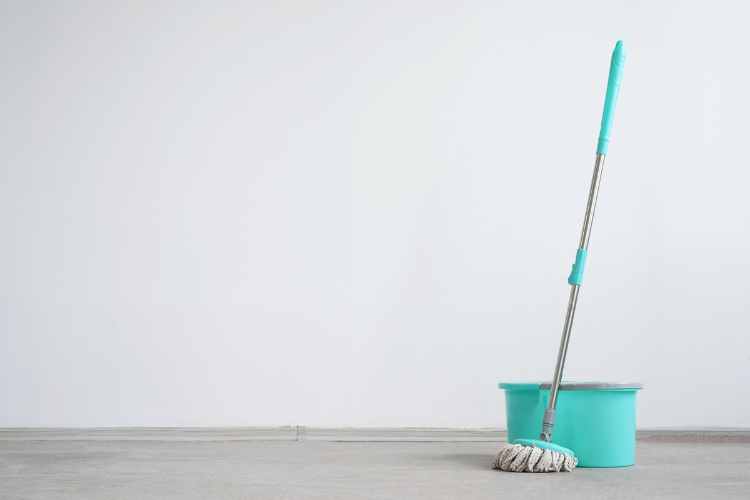Are you worried because your bluestone is not getting cleaned with a mild detergent and water? If you are facing the same problem and unable to find a solution for cleaning your bluestone to avoid damage. The bluestones are colorful and beautiful, making your house attractive and easy to maintain. However, the maintenance of bluestone is necessary because the results of ignorance of proper care can ruin the look of your beautiful room or office.
In this article we will provide all the details about bluestone and its uses and benefits, additionally, you will learn how to clean it.
Flagstone and bluestone
To examine bluestone, first requires you to learn more about flagstone. Flagstone is a level sedimentary stone with fissile sheet material planes. It is normally parted into layers as indicated by these planes and they are usually utilized for different purposes, such as patios and pool decks, roofing, facades, and walkways.
Flagstone is composed of bounding minerals together including calcite, iron oxide, and silica. These internal materials are the reason behind the beautiful and colorful flagstone, one of which is an incredible blue stone called “bluestone”.
History of Flagstone
The word flagstone is derived from the Middle English term “flagge,” which signifies turf. The use of flagstone was first done by Europeans in the thirteenth century. They started utilizing flagstone for several purposes such as floors, walls, and ceilings. During that time the use of flagstone became especially prevalent for the interior enclosures of castles.
The use of Flagstone floors still exists in the Muchalls Castle of Scotland and Lindisfarne Castle in England. More importantly, the Portage Park of Chicago is well-known for its expensive flagstone ornamentations.
Pennsylvania’s Bluestone
Pennsylvania bluestone is remarkable in its aspect of the United States. Bluestone originates only from the northeastern section of the States as well as the southern tier of New York and northern New Jersey.
In general terms, Bluestone is layered sandstone that exists in a range of different types of colors such as gorgeous blue, green, lilac, rust, and more. Around 360 million years ago, when the waves carried sand into the Catskills, it began to evolve. Bluestone is composed of mica, sand, feldspar, and numerous other minerals. How blue the stone is, will depend on the distribution and makeup of these minerals.
What does “True Bluestone” mean?
“True Blue” bluestone means a stone that has the quality of not exhibiting any additional colors other than blue when removed from a quarry.
True blue veins are more unusual than full color which are also known as variegated veins. Moreover, it can also include waves of other colors varied in with the blue due to implanted minerals. Due to this, true blue flagstone is more costly in comparison to the one with full color. Even though the minerals in the stone are exposed to the environment, the pure blue stone may however over time exhibit varied colors.
Why should you use bluestone?
Many reasons for using Pennsylvania bluestone can make them an attractive selection for homeowners to include in your hardscaping projects. The given below are a few reasons you can consider using bluestone:
- The bluestone is formed with a hard-wearing material which means it doesn’t require any maintenance and can be used for years.
- The bluestone tiles are a great option for use in slippery areas such as the bathroom and kitchen because it is not slippery.
- The maintenance of bluestone tiles is easy however it just needs a little extra sweeping and mopping to look appealing.
How to Prepare Bluestone for Use?
The bluestone is not used in its natural state and is transformed before use at home. For transforming bluestone from the raw state that is found in nature it is cut out of the quarry into cubes so that it can be used in homes or businesses.
The bluestone found in nature is cut out of the quarry into cubes and later treated in one of the two types that depend on the density of the stone. Generally, the spalling process is used with the densest stone. In the spalling process, bluestone is cut along horizontal sections once it is removed from its natural environment. Later it is thoroughly soaked with water and then heated with a propane torch.
The spalling process features a perfect even feature by producing thermal flagstone. It is then completely soaked in water and treated with a propane torch. Thermal flagstone is created by the spalling process additionally it benefits the flagstone by having a flawlessly smooth surface.
Less dense cubes or the cubed in which layering is visible only when removed from the quarry will become natural cleft flagstone after a few weeks of air-drying.
The bluestone will inherently separate along fissures during the time of air drying. The result of this detachment is quite irregular but has a beautiful surface. The finishing of Both thermal and natural cleft flagstone materials is outstanding when applied to any work.
As the thermal cleft flagstone undergoes more processing it is expensive, however, on the other side the Natural cleft flagstone involves less processing in its production process; it has always been less expensive than the thermal cleft flagstone. However, there is a surface variation with that reduced price that is not permanently satisfactory.
Why Is Bluestone So Appealing?
The reason why people love bluestone is its unique color, incredible strength, superior density, and fine grain. Due to having features like uniqueness in color and unbreakability, it is most often used by people on decks and patios so it doesn’t get any cracks and breakages easily.
Another great benefit of using bluestone is that it can be cut into custom size slabs so people prefer to use it for walls, sidewalks, steps, indoor floors, and fireplaces as well. The major drawback of bluestone is that it also holds heat making it potentially quite hot after extended exposure to direct sunlight.
The main disadvantage of bluestone is that it retains heat, which might make it a little hot after prolonged contact with sunlight.
What is the process of Maintenance of Bluestone?
If you want your bluestone to look appealing then it requires proper caring. In addition to this Bluestone is one of the easiest surfaces to be maintained by homeowners. It is quite easy to take care of your bluestone as you don’t require it to provide its sealing. To make your bluestone more shiny and appealing you just need to clean it with water and brush.
However, if in any case your bluestone is stained you are required to put a few drops of vinegar and water on the stained surface. Now you just have to scrub it out or you can buy specialty cleaners for cleaning unusual or severe stains on your bluestone.
Moreover, for the proper maintenance of your bluestone, the only maintenance suggestion is a power washing once every few years. Bluestone owners must be aware of the fact that the stone can be grooved by intense water pressure so they should avoid power wash on the highest level.
The Final Words
Bluestone is an ideal choice for you if you want to avoid the maintenance of your floors again and again. The bluestone is used by people in their properties because they look appealing and require low-cost maintenance. Just a regular cleaning with a mild detergent and water can make them look shiny and amazing.
We hope that you found this article informative and that it answered all your queries related to bluestone and its maintenance.
FAQs
1.What is bluestone?
Ans. Bluestone is a type of sedimentary rock that is found in several parts of the world and is of different colors such as blue, green, grey, or black. The bluestone that is used in offices, rooms, or other places is cut out from a bluestone that is already blue.
2.How do I need to clean the bluestone?
Ans. For proper cleaning of your bluestone, you just require a mild detergent and water or you can also try power washing your bluestone once every few years.
3. When to use vinegar for cleaning Bluestone?
Ans. Using a stronger cleaning solution such as vinegar or lemon for cleaning Bluestone is not suggested until you find any stain on your bluestone. Vinegar should only be used on the stained spots, not on the whole surface. Moreover, do not forget to rinse the floor properly after using any strong cleaning solutions to avoid damage to your bluestone.























